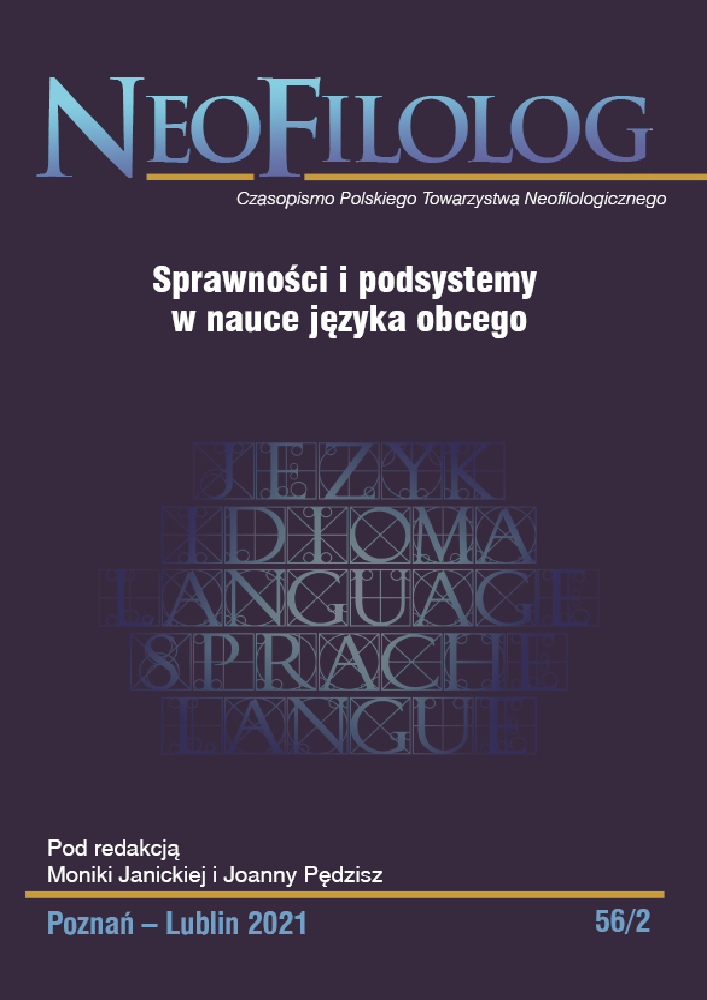Abstrakt
The concept of mediation in foreign language teaching and learning is becoming increasingly present in literature, but due to the evolving nature of this term, many studies do not include all of its aspects. Since the publication of Common European Framework of Reference for Languages in 2001, the notion of mediation has been considerably developed and the scope of mediation activities has been extended. This article is devoted to the term “mediating concepts”, which is used in Companion Volume from 2018, which updates the CEFR 2001. On the basis of the latest studies, we would like to discover what is understood by the latest idea of “mediating concepts” and what are the practical applications of these theoretical considerations, using the example of a new method of teaching French: C’est parti!
Bibliografia
Cadre européen commun de référence pour les langues : apprendre, enseigner, évaluer. Volume complémentaire avec de nouveaux descripteurs (2018). Strasbourg : Conseil de l’Europe.
Cadre européen commun de référence pour les langues : apprendre, enseigner, évaluer. (2001). Strasbourg : Conseil de l’Europe.
Coste D., Cavalli M. (2015), Éducation, mobilité, altérité. Les fonctions de médiation de l’école. Strasbourg : Conseil de l’Europe.
De Carlo M. (2012), Traduction et médiation dans l’enseignement-apprentissage linguistique. « Études de linguistique appliquée », no 167, pp. 299–311.
Franić I. (2011), Le concept de médiation proposé par le CECR : les représentations des apprentis traducteurs sur la médiation. « Synergies Europe », n° 6, pp. 39–49.
Gouiller F. (2019), Les clés du Carde. Enjeux et actualité pour l’enseignement des langues aujourd’hui. Paris : Didier.
Janowska I. (2016), Od metody gramatyczno-tłumaczeniowej do mediacji językowej. Tłumaczenie w dydaktyce języków obcych, (in :) Lipińska E., Seretny A. (éds), Tłumaczenie dydaktyczne w nowoczesnym kształce-niu językowym. Kraków: Księgarnia Akademicka, pp. 37–53.
Janowska I. (2017), Mediacja i działania mediacyjne w dydaktyce języków obcych. « Języki Obce w Szkole », no 3, pp. 80–86.
Kucharczyk R. (2020), Językowe działania mediacyjne na lekcjach języka obcego. Od teorii do praktyki dydaktycznej. « Języki Obce w Szkole », no 2, pp. 5–14.
Kusiak-Pisowacka M. (2015), Ewaluacja podręcznika w nauczaniu języków obcych. « Lingwistyka stosowana », no 14, pp. 65–75.
Melo-Pfeifer S., Schröder-Sura A. (2018), Les tâches de médiation dans les manuels de Français Langue Étrangère pour le secondaire en Allemagne. « Recherches en didactique des langues et des cultures », no 15/3, pp. 1–19.
North B., Piccardo E. (2016), Cadre européen commun de référence pour les langues : apprendre, enseigner, évaluer. Élaborer des descripteurs pour illustrer les aspects de la médiation pour le CECR. Strasbourg : Conseil de l’Europe.
Piccardo E. (2012), Médiation et apprentissage des langues : pourquoi est-il temps de réfléchir à cette notion ? « Études de linguistique appliquée », no 167, pp. 285–297.
Piotrowska-Skrzypek M., Gajos M., Deckert M., Biele D. (2019), C’est parti ! 1. Kraków: Wydawnictwo Draco Sp. z o.o.
Piotrowska-Skrzypek M., Gajos M., Deckert M., Kalinowska E., Sowa M. (2019), C’est parti ! 2. Kraków: Wydawnictwo Draco Sp. z o.o.
Rosen E, Minns Ph. (2008), Les activités de médiation au service du perfectionnement des compétences d’interprètes de conférences en formation – illustration d’un mode de contextualisation du CECR. « Travaux de didactique du FLE », no 59, pp. 133–151.
Schädlich B. (2016), Médiation linguistique et didactique du plurilinguisme et du pluriculturalisme, (in :) Medhat-Lecocq H., Negga D., Szende T. (éds), Traduction et apprentissage des langues. Entre médiation et remédiation. Paris : Éditions des archives contemporaines, pp. 81–91.
Sowa M., Deckert M., Piotrowska-Skrzypek M. (2020), C’est parti ! 3. Kraków: Wydawnictwo Draco Sp. z o.o.
SITOGRAPHIE
https://podreczniki.men.gov.pl [consulté le 22 mars 2021]
https://wydawnictwodraco.pl/cest_parti_1 [consulté le 22 mars 2021].
Licencja
Prawa autorskie (c) 2021 Halina Chmiel-Bożek

Utwór dostępny jest na licencji Creative Commons Uznanie autorstwa – Bez utworów zależnych 4.0 Międzynarodowe.
Przedstawiany utwór (artykuł) upubliczniany jest na podstawie umowy z autorem i na licencji Creative Commons Attribution-NoDerivatives 4.0 International (CC BY-ND 4.0).
Użytkownicy mają obowiązek podania wraz z rozpowszechnionym utworem, informacji o autorstwie, tytule, źródle (odnośniki do oryginalnego utworu, DOI) oraz samej licencji;
- bez tworzenia utworów zależnych,
- utwór musi być zachowany w oryginalnej postaci.
Uniwersytet im. Adama Mickiewicza w Poznaniu zachowuje prawo do czasopisma jako całości (układ, forma graficzna, tytuł, projekt okładki, logo itp.).

